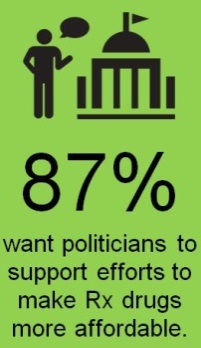AARP Eye Center
New AARP survey finds most consumers age 50-plus believe prescription medications are too expensive
Washington, DC – The vast majority (81%) of adults age 50-plus say prescription drug prices are too high and nearly 9 in 10 (87%) want

politicians to support efforts to make them more affordable, according to a new AARP Public Policy Institute consumer survey.
“This survey confirms what we expected: People want more affordable prescription drugs,” said AARP Chief Advocacy and Engagement Officer Nancy LeaMond. “The public is making it increasingly clear that profiteering by drug companies at the expense of Americans is unacceptable. People are worried about high drug prices and many are struggling because they can’t afford their medications.”
AARP’s “2015 Survey on Prescription Drugs” polled Americans age 50-plus to understand their prescription drug usage and opinions regarding their cost, as well to understand their views on various proposals to help keep drug prices affordable.
The survey found that 3 out of 4 adults age 50-plus take at least one prescription medication on a regular basis. More than 8 in 10 (86%) of seniors age 65-plus regularly take prescription drugs; 53% take four or more regular medications. “We’re talking about millions of people who are impacted by high drug prices every single day,” said LeaMond.
Survey highlights:
• 98% say it’s important to be able to compare the safety and effectiveness of prescription drugs
• 87% say it’s important for politicians – especially those running for president – to support efforts to reduce prescription drug costs.
• 76% say the government should be doing more about prescription drug prices
• 84% say drug companies should publicly explain how they price their products.
• 93% support allowing Medicare to negotiate for lower drug costs.
Over half (55%) of the survey respondents who reported not filling a prescription in the past two years said that cost was a factor. In general, prescription drug affordability concerns were greater among those in poor health, as well as those with lower incomes and lower levels of education. “No one should have to go without the medications they need because of cost,” said LeaMond.
Survey methodology: This survey of a nationally representative sample of 1,834 adults age 50-plus was conducted for AARP by GfK online from December 1–11, 2015. The data was weighted by age, gender, race, ethnicity, education, Census region, metropolitan status, household income, and primary language (Hispanics/Latinos only). The margin of error for the national sample of 1,834 adults age 50-plus is +/- 2.8%. The margin of error among subgroups is higher.
The full results of the survey can be found here: www.aarp.org/2015PrescriptionDrugSurvey
Additional Resources
• Trends in Retail Prices of Specialty Prescription Drugs Widely Used by Older Americans, 2006-2013
• Trends in Retail Prices of Generic Prescription Drugs Widely Used by Older Americans, 2006-2013
• Trends in Retail Prices of Brand Name Prescription Drugs Widely Used by Older Americans, 2006 to 2013
• AARP Bulletin article, “Feeling the Pain of Costly Prescription Drugs” (Jan/Feb 2015)
About AARP
AARP is a nonprofit, nonpartisan organization, with a membership of nearly 38 million that helps people turn their goals and dreams into 'Real Possibilities' by changing the way America defines aging. With staffed offices in all 50 states, the District of Columbia, Puerto Rico, and the U.S. Virgin Islands, AARP works to strengthen communities and promote the issues that matter most to families such as healthcare security, financial security and personal fulfillment. AARP also advocates for individuals in the marketplace by selecting products and services of high quality and value to carry the AARP name. As a trusted source for news and information, AARP produces the world’s largest circulation magazine, AARP The Magazine and AARP Bulletin. AARP does not endorse candidates for public office or make contributions to political campaigns or candidates. To learn more, visit www.aarp.org or follow @aarp and our CEO @JoAnn_Jenkins on Twitter.























































